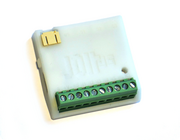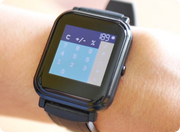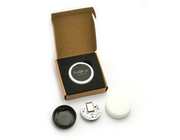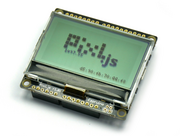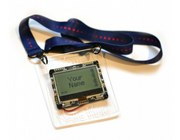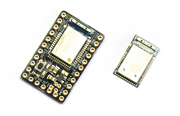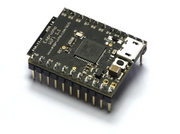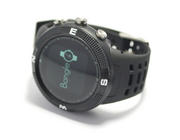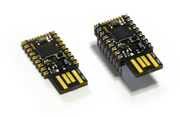Espruino on ESP32
Note: *This page documents running the Espruino firmware on the ESP32 board.
Warning: Espruino on the ESP32 defaults to 115200 baud on its serial interface. This means you will need to adjust this setting in the IDE if you use that. (Other Espruino ports default to 9600 baud.)
Contents
- Overview
- Getting Started
- Installing drivers
- Flashing
- Espruino Web IDE
- Running some basic JavaScript
- Connecting to Wifi
- Creating a basic web-server
- Bluetooth
- GPIO Pins
- Problem
- Analog Read / Write Example
- System time
- digitalPulse implementation
- setWatch implementation
- Saving code to flash
- Flash map and access
- Further reading
- Troubleshooting
- Official Espruino Boards
Overview
The ESP32 is a dual core Tensilica LX6 microcontroller with 520 KB SRAM, integrated Wifi, Bluetooth, and more. Espruino is a very lightweight JavaScript interpreter that runs on the ESP32, and other microcontrollers.
This documentation is intended for those who want to run JavaScript on any ESP32 microcontrollers. It will describe how to flash the ESP32 with the latest firmware, connect to Wifi and get the other pins going.
There are a few different boards that contain the ESP32 microcontroller. These instructions below should be generic enough for all boards, but you may have to adapt the instructions in places.
Quick links
- Online ESP32 Espruino Flashing tool
- Download the latest ESP32 firmware release
- Download 'cutting edge' ESP32 firmware - these may not always work
- Espruino ESP32 Forum - Main support forum
- ESP32 Forum
- Developer chat for Espruino ESP32 - Focuses on development issues.
ESP32 Features
- 240 MHz dual core Tensilica LX6 microcontroller
- Built-in Wifi and Bluetooth (classic and BLE)
- 2.2V to 3.6V operating voltage
- 32 GPIO pins:
- 3x UARTs, including hardware flow control
- 3x SPI
- 2x I2S
- 12x ADC input channels
- 2x DAC
- 2x I2C
- PWM/timer input/output available on every GPIO pin
- Supports external SPI flash up to 16 MB
- SD-card interface support
- Sensors: Ultra-low noise analog amplifier, Hall sensor, 10x capacitive touch interface, 32 kHz crystal oscillator
Limitations / Work in Progress
Supported by Espruino on the ESP32:
- onewire
- hardware SPI
- hardware I2C
- DAC
- ADC
- Serial
- WIFI - as a client and access point
- Bluetooth LE - BLE
Not supported by Espruino on the ESP32 (yet):
- No Over-The-Air (OTA) firmware updates.
- Bluetooth Classic
Known Issues
- Espruino Web IDE had issues with the ESP32 back in 2017, see below.
Getting Started
Installing drivers
Depending on the board and operating system you have, you might need to install the FTDI or Silicon Labs USB driver:
Flashing
If your device is not already flashed, below are the instructions. Flashing involves downloading the latest firmware to your PC and then copying via USB cable to the microcontroller.
Easy Online Flashing
If you have a Chromium-based web browser it's possible to flash your ESP32 device direct from the browser! Click here to flash Espruino to your board
If that fails you'll have to install it manually (see below)
Writing Firmware
Download esptool if you haven't downloaded it already.
To flash the ESP32 we use esptool.py. Before you run esptool.py, make sure
you know the flashing procedure for the board you have. Some boards have a flash
button, that you press when you are running the flash utility. For boards such
as the Dev Kit C board - The DTS and RTS lines are used and put the board into bootloader mode automatically
PyCom boards
for PyCom boards with the ESP32 microcontroller you need to:
- connect the ESP32 board to your PC using the USB cable.
- hold pin G23 to GND;
- run the following command; and then
- press the reset button.
ESP-WROOM-32 (plain, no dev board)
- connect pins as follows
VCC -> VCC(3.3V) GND -> GND EN -> VCC TX -> RX (on usb controller) RX -> TX (on usb controller) IO0 -> GND (only for flash) - run the following command; and then
- leave IO0 floating (not connected) and reset chip
ESP-WROOM-32 (dev board)
Flashing can be done by USB, no special actions on pins are needed.
Flashing command
The following command will write the flash to the ESP32. Note you need to
select the correct port, on Windows it will be something like COM3.
Initial flash
esp-idf/components/esptool_py/esptool/esptool.py \
--chip esp32 \
--port /dev/ttyUSB0 \
--baud 921600 \
--after hard_reset write_flash \
-z \
--flash_mode dio \
--flash_freq 40m \
--flash_size detect \
0x1000 bootloader.bin \
0x8000 partitions_espruino.bin \
0x10000 espruino_esp32.bin
If the bootloader.bin and partitions_espruino.bin files are not
included from the same source you acquired the espruino_esp32.bin build,
they should be available in the corresponding espruino_1v92.*_esp32.tgz
package of the Travis cutting-edge builds.
Subsequent updates
This example is to replace existing Espruino firmware after a new release:
esp-idf/components/esptool_py/esptool/esptool.py \
--chip esp32 \
--port /dev/ttyUSB0 \
--baud 921600 \
--before esp32r0 \
--after hard_reset write_flash \
-z \
--flash_mode dio \
--flash_freq 40m \
--flash_size detect \
0x10000 espruino_esp32.bin
You should see something like the following:
esptool.py v2.0-beta1
Connecting........................
Uploading stub...
Running stub...
Stub running...
Changing baud rate to 921600
Changed.
Attaching SPI flash...
Configuring flash size...
Auto-detected Flash size: 4MB
Compressed 894288 bytes to 517230...
Wrote 894288 bytes (517230 compressed) at 0x00010000 in 8.4 seconds (effective 848.5 kbit/s)...
Hash of data verified.
Leaving...
Hard resetting...
Your device is flashed.
Building Firmware and installing the toolchain
You can get the Espruino firmare from the cutting-edge builds.
Get the file ending in _esp32.bin.
You can also build the Espruino firmware yourself:
The following work in a bash shell environment, you will need git, and other essential build tools (e.g. on Ubuntu run sudo apt-get install build-essential).
# Get the Espruino source code
git clone https://github.com/espruino/Espruino.git
cd Espruino
# Download and set up the toolchain ('source' is important here)
source scripts/provision.sh ESP32
# Clean and rebuild
make clean && BOARD=ESP32 make
You will have a file called espruino_esp32.bin. This is your ESP32 firmware.
See https://github.com/espruino/Espruino/blob/master/README_Building.md for more information.
Espruino Web IDE
The Espruino Web IDE is a basic development environment that allows you to write your code and deploy it to the ESP32.
minicom / CuteCom
There are other methods to connect to your ESP32, not just Espruino Web IDE. Two very basic tools are minicom, CuteCom, and screen which may already be installed on your system. Another cross platform terminal program with a friendly interface is CoolTerm.
screen is usually used for multiplexing terminals, keeping terminal sessions alive while you're logged out, and so forth. However, it will also function as a serial terminal
screen /dev/ttyUSB0 115200
Minicom is a basic console based tool that allows you to connect to a serial device, such as the ESP32. Below is the command to get you connected to the ESP32.
minicom --baudrate 115200 --device /dev/ttyUSB0
CuteCom is also a basic GUI tool that allows you to connect to a serial device. Run CuteCom and connect via the correct port.
Running some basic JavaScript
Once you have the espruino console running you will be able run JavaScript directly
in the console. You should see a > character with a flashing cursor, this
indicates that espruino is waiting for input. If you don't see it press the enter key.
Type the following:
console.log('Hello ESP32!');
It will output the following:
Hello ESP32!
=undefined
You should have expected the "Hello ESP32!" text, but probably didn't expect
"=undefined". This is normal and it indicates the result of the last operation, which in this case is the return value of console.log, which is always undefined.
Connecting to Wifi
If your board with the ESP32 has an antenna connection point, connect your Wifi antenna. Many boards have an in-built antenna so this may not be required.
var ssid = 'YOUR_SSID';
var password = 'YOUR_SSID_PASSWORD';
var wifi = require('Wifi');
wifi.connect(ssid, {password: password}, function() {
console.log('Connected to Wifi. IP address is:', wifi.getIP().ip);
wifi.save(); // Next reboot will auto-connect
});
Additional commands:
wifi.save(): This will save the Wifi details such that the ESP32 will reconnect to the wifi after a reboot.wifi.scan((ap) => { console.log(ap) }): List all the access points seen by the ESP32.wifi.setHostname('myESP32'): set the hostname. (Not currently implemented.)
Note: The ESP32's Wifi implementation supports both a simple access point mode and a station mode. The station mode is highly recommended for normal operation as the access point mode is very limited. It supports 4 stations max and offers no routing between stations.
Note: You need a good 3.3v regulator with a solid power supply. If you get errors as soon as Wifi starts it's probably because the power is insufficient. A 500-600mA regulator with at least 22uF capacitor is recommended.
Creating a basic web-server
Once you have wifi going you will be able to create a simple web server.
var ssid = 'YOUR_SSID';
var password = 'YOUR_SSID_PASSWORD';
var port = 80;
function processRequest (req, res) {
res.writeHead(200);
res.end('Hello World');
}
wifi.connect(ssid, {password: password}, function() {
var http = require('http');
http.createServer(processRequest).listen(port);
console.log(`Web server running at http://${wifi.getIP().ip}:${port}`)
});
This will output something like Web server running at http://10.42.0.119 and you will be able to browse to that address.
Bluetooth
See https://www.espruino.com/BLE+Communications
GPIO Pins
The ESP32 has 40 GPIO pins. These are available in Espruino as the variables D0 to D40, each of these variables are instances of the Pin class.
Hover the mouse over a pin function for more information. Clicking in a function will tell you how to use it in Espruino.
- Purple boxes show pins that are used for other functionality on the board. You should avoid using these unless you know that the marked device is not used.
- ! boxes contain extra information about the pin. Hover your mouse over them to see it.
- 3.3v boxes mark pins that are not 5v tolerant (they only take inputs from 0 - 3.3v, not 0 - 5v).
- GND is ground (0v).
- ADC is an Analog to Digital Converter (for reading analog voltages)
- DAC is a Digital to Analog Converter (for creating analog voltages). This is not available on all boards.
- SPI is the 3 wire Serial Peripheral Interface.
- USART is a 2 wire peripheral for Serial Data.
- I2C is the 2 wire Inter-Integrated Circuit bus.
For example, connect GPIO25 and D14 with a wire. Then run the following code.
D14.mode('output');
D25.mode('input');
console.log('Before: ', D25.read());
D14.set(); // Set the D14 pin to output a HIGH value.
console.log('After: ', D25.read());
This will output:
Before: false
After: true
Note: The ESP32 GPIO pins support totem-pole and open-drain outputs, and they support a weak internal pull-up resistor (in the 20KOhm-50KOhm range). The Espruino D0 through D32 pins map directory to GPIO0 through GPIO32 on the ESP32. Remember that GPIO6 through GPIO11 are used for the external flash chip and are therefore not available. Also, GPIO0 and GPIO2 must be pulled-up at boot and GPIO15 must be pulled-down at boot.
The ESP32 ADC function is available on any pin (D0-D15) but really uses a separate pin on the ESP32 (this should be changed to an A0 pin).
I2C Example
Below is an example of the HD44780 LCD controller. It uses the I2C class.
I2C1.setup({ 'scl': D17,
'sda': D16,
bitrate: 100000 });
var lcd = require('HD44780').connectI2C(I2C1);
lcd.print('Hello ESP32!!');
SPI Example
Below is an example for the PCD8544 LCD controller (48 × 84 pixels matrix LCD). It uses the SPI class.
/*
Display ESP-32 DEF Colour
LED 3V3 N/A
SCLCK GPIO4 Green IO05
DN<MOSI> GPIO16 Yellow
D/C GPIO17 Orange
SCE GPIO5 Red
RST GPIO18 Brown
GND GND Grey
VCC 3V3 Blue
BackLight GND Purple
*/
SPI2.setup({ sck:D5, mosi:D23 });
var g = require('PCD8544').connect(SPI1,
D17 /* RS / DC */,
D18 /* CS / CE */,
D16 /*RST*/, function() {
g.clear();
g.setRotation(2); //Flip display 180
g.drawString('Hi Esp32',0,0);
g.drawLine(0, 10, 84, 10);
g.flip();
});
Serial / UART Example
There are two serial ports (UARTs) available for use on the ESP32 with Espruino. These are accessed
throught the Serial class. The Serial1 and Serial2
functions are available for use. Note that if you are accessing the ESP32 via serial terminal
Serial1 may already be used, hence it's not available (use Telnet if this is an issue).
For the example below, connect a wire from the GPIO04 (transmit pin, TX) and GPIO15 (receive pin,
RX).
Serial2.setup(9600, { tx: D4, rx: D15 });
Serial2.on('data', function(data) {
console.log('Serial2: ', data);
});
Serial2.print('Hello UART');
This will output:
Serial2: Hello UART
Note: The ESP32 has two UARTS. UART0 (Serial1) uses GPIO10 for TX and GPIO32 for RX and is used by
the Espruino JavaScript console. It can be used for other things once the Espruino console
is moved to another device. For instance calling LoopbackA.setConsole() will move the console
to 'loopback' (where is can be accessed using LoopbackB), and will free up Serial1 for
use like any normal Espruino Serial port.
Digital Read / Write Example
PWM on most pins. True DAC on GPIO25 and GPIO26.
First version of PWM uses ledc driver. Usually, this matches needs for frequency much more than sigmadelta. Mapping of PWM channel to timer is done in a special way. There are 5 channel usable, as long as 5Khz are ok for frequency. Channels are internally controlled. If you try to use more than 5, you will get a message. Left 3 channels are designed to support a frequency of your choice, as long as it is between 1hz and 78 Khz. If you try to use a 4th channel with a frequency, other than 5Khz you will a meesage.
Problem
Handling of PWM with those 5/3 method is not always easy to follow. As long as we don't have a better solution, its better to have this than nothing. Limitation of frequency is boring, but as long as we use it for analog output, it should be acceptable. Please have in mind, PWM via analog always need a lowpass filter, usually a simple RC.
Analog Read / Write Example
There are two ADC channels but only ADC-1 is support at the moment. The ADC-1 channel is accessible through IO35 and IO36(VP_SENSOR).
ADC PINs should not be connected to a voltage higher than VCC - if a higher input voltage is needed, a resistor should be added between the input and the ADC and then the real voltage could be calculated by including the resistor's voltage drop in the equation.
usage example: reading analog voltage from IO35
var reading = analogRead(D35);
// reading is a float between 0 and 1
var estimatedInputVoltage = reading * 3.3;
more information on espruino ADC docs and analogRead method
Unique Identifier for the ESP32
The ESP32 does not have a serial number. It does have two mac addresses "burned-in", which one can
use for identification purposes. getSerial() returns the MAC address of the STA interface.
System time
From a JavaScript perspective, we can get and set the system time using
the JS functions called getTime() and setTime(). These get and take
a time in seconds (float).
digitalPulse implementation
There are 8 channel available. Each one with is connected to a pin. Timimg goes down to micro secs. Implemented with the esp-idf RMT driver.
setWatch implementation
- D0
- D12 .. D19
- D21, D22
- D25 .. D27
- D34 .. D39
Saving code to flash
Currently 64KB of flash are reserved to save JS code to flash using the
save() function. This area is also used for E.saveBootCode()
If the save() area contains something that crashes Espruino or otherwise doesn't let you reset the system you can disable whatever is saved by flashing blank.bin to 0x100000.
Flash map and access
Note: if you are looking for a free flash area to use, call require( "Flash").getFree(),
which will return a list of available areas (see docs).
Current ESP32 modules are 4Mb.
The result of all this is the following:
| Start | Length | Function |
|---|---|---|
| 0x000000 | 4KB | Secure Boot |
| 0x008000 | 4KB | Bootloader |
| 0x009000 | 16KB | nvs - esp-idf non-volatile storage area |
| 0x00d000 | 8KB | otadata - esp-idf keeps track on which the current firmware to boot |
| 0x010000 | 960KB | factory - the initial espruino firmware. |
| 0x100000 | 64KB | js_code - the saved espruino interpreter and E.setBootCode() |
| 0x200000 | 1024KB | ota_0 - area for ota updates (not yet implemented) |
| 0x300000 | 1024KB | 1Mb Flash Fat Filesystem |
This is defined in partitions_espruino.csv in the EspruinoBuildTools repository
The last 1Mb has been defined as a flash FAT filesystem. It needs to be intialised for first use - this does it in a safe way that won't delete existing files:
try {
fs.readdirSync();
} catch (e) { //'Uncaught Error: Unable to mount media : NO_FILESYSTEM'
console.log('Formatting FS - only need to do once');
E.flashFatFS({ format: true });
}
you can then use the filesystem with fs or File objects:
fs.writeFileSync('hello world.txt', 'This is the way the world ends\nHello World\nnot with a bang but a whimper.\n');
fs.readFileSync('hello world.txt');
Further reading
TODO: Add additional resources not already covered.
Troubleshooting
Guru Meditation Error
Symptom:
Guru Meditation Error of type InstrFetchProhibited occurred on core 0. Exception was unhandled.
Register dump:
PC : 0xffffffff PS : 0x00060c30 A0 : 0x8008e036 A1 : 0x3ffd54b0
A2 : 0x3f400148 A3 : 0x3ffb6952 A4 : 0x00000008 A5 : 0xffffffe8
A6 : 0xffffffa4 A7 : 0x3ffb1fa0 A8 : 0xffffffff A9 : 0x3ffd54c0
A10 : 0x00000000 A11 : 0x00000002 A12 : 0x5fff0007 A13 : 0x00000000
A14 : 0x00000000 A15 : 0x00000000 SAR : 0x00000000 EXCCAUSE: 0x00000014
EXCVADDR: 0xfffffffc LBEG : 0x4000c2e0 LEND : 0x4000c2f6 LCOUNT : 0x00000000
Cause: if it happens whenever wifi tries to connect then the chip is not getting enough power. Solution: use a designated power source (not the USB serial adapter), add capacitors to the power line
Official Espruino Boards
This page is auto-generated from GitHub. If you see any mistakes or have suggestions, please let us know.
